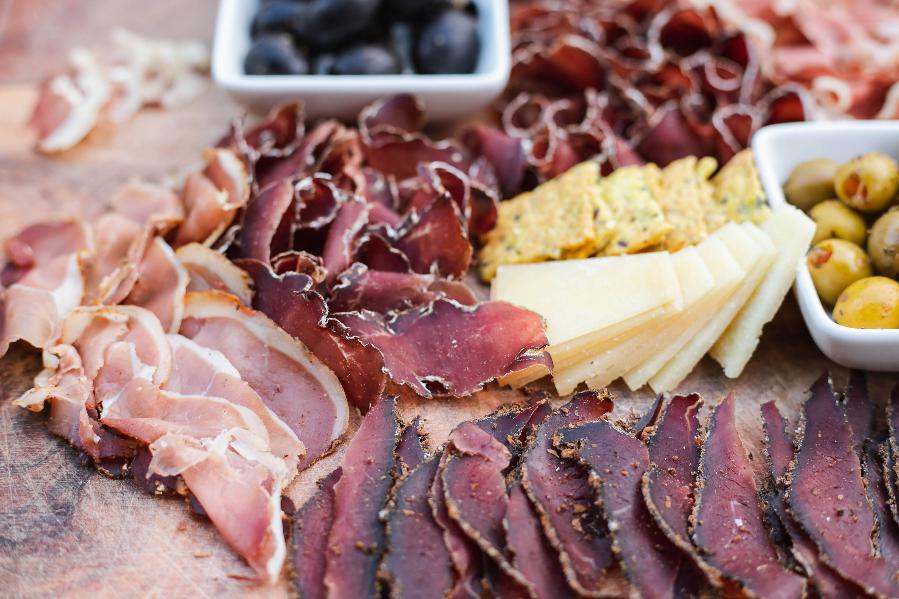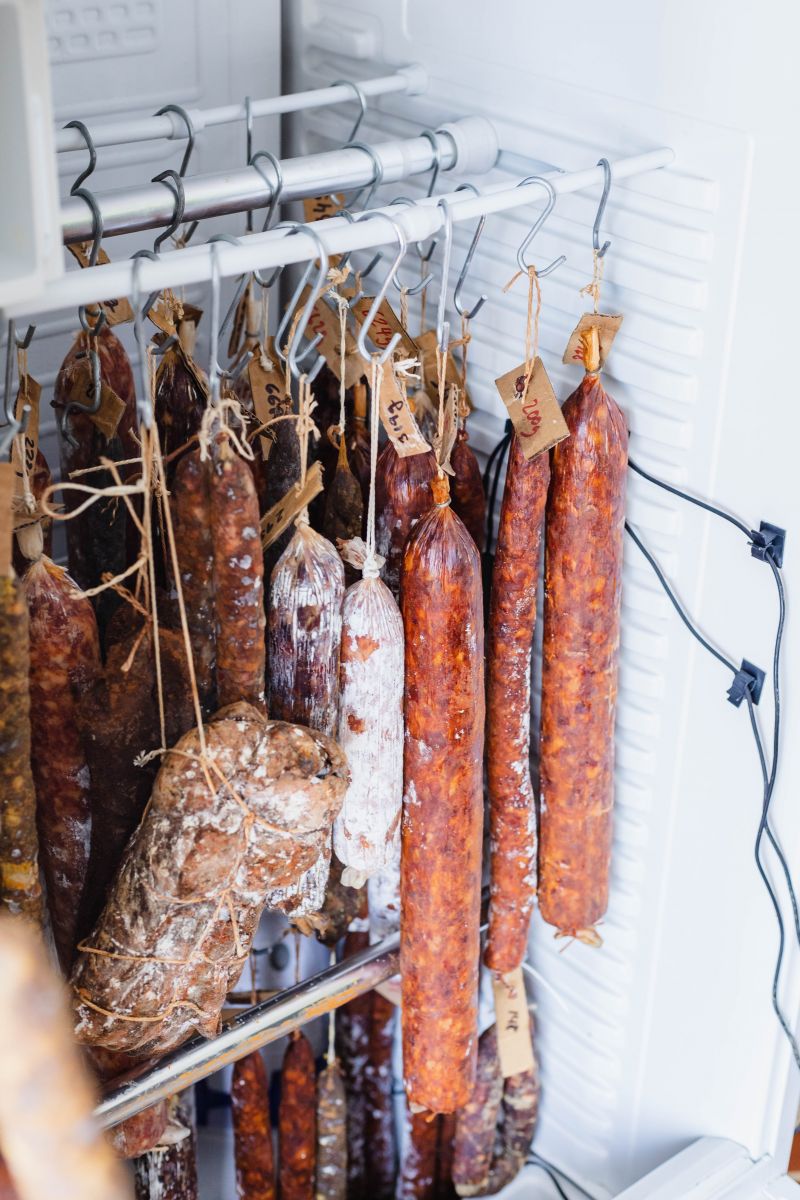“Cured meat” sounds simple, but it encompasses a range of techniques and outcomes. I’ll define it clearly, then walk through how curing works based on what I’ve made at home and studied over the years.
Some cured meats are ready to eat with no final cooking—prosciutto or a dry-cured picante salami are classic examples.
Others are cured first and then cooked or hot-smoked. Pastrami is a good example: it’s brined, seasoned, smoked, and cooked to serving temperature.
There are “in-between” styles too, like dry-cured, cold-smoked bacon. I cure the bacon, add gentle cold smoke for aroma and surface support, then cook it before eating.
What Is Cured Meat?
Before we get into methods, it’s helpful to pin down a precise definition. The aim is either preservation with drying, or moisture management for cooking—both start with salt.
Short Answer
Curing is adding salt to meat to manage moisture and slow unwanted microbial activity. Depending on the project, the goal is either flavor + moisture retention during cooking (hot smoking) or preservation + drying (dry/wet salt curing) for longer projects.
Canning and pickling are all variations of this, using salt curing as part of the process.
Why People Cure Meat (Flavor vs. Preservation)
For cooking-focused products (ham, pastrami, deli meats), a lighter cure seasons the meat and helps it stay juicy through the cook.
For preservation-focused products (prosciutto, pancetta, bresaola), a deeper cure followed by controlled drying reduces available water and builds complex flavor over weeks or months.
How Curing Works (The Fundamentals)
At a high level, salt interacts with muscle proteins and water. It helps meat hold moisture during cooking, diffuses inward to season evenly, and—when the goal is preservation—supports a reduction in water activity (aw) so spoilage slows under controlled conditions.
Salt’s Two Key Roles: Water Binding & Diffusion
Water Binding (Moisture Retention in Cooking/Ham)
Salt interacts with muscle proteins, so the meat retains more moisture. That’s why a properly brined turkey or ham often tastes juicier—the curing step reduces moisture loss during the cook.
Diffusion & Osmosis (Getting Salt Evenly Into Meat)
Apply salt to the surface, and it gradually moves inward toward an even concentration. As salt enters, some water migrates outward, lowering surface moisture. The result is even seasoning and a foundation for either cooking or preservation.
Reducing Water Activity (Aw) & Inhibiting Spoilage
Preservation projects aim for a measurable drop in aw. Lower aw makes it harder for spoilage microbes to thrive. Achieving this safely requires steady temperature, humidity, airflow, and time—plus consistent processes that you can repeat.
Where Nitrite/Nitrate Fit
Only pink curing salts include nitrite or nitrate. They’re used in many cooked deli meats and long-term dry-curing styles to support predictable results and the familiar cured color. Whether to use them depends on the project and your preferences—salt remains the core curing agent.

Main Types of Curing
Most confusion melts away once you separate preservation-first styles from cooking-first styles. Below are the three broad families I use and teach, with quick notes on technique, texture, and where each shines.
Dry-Cured / Air-Cured (No Cooking)
Salt is applied, the cure equalizes, and the meat is dried under controlled temperature, humidity, and airflow until the target weight loss and texture are reached. Done well, you get deep flavor and a sliceable, silky texture without any finishing cook.
Prosciutto, Bresaola, Pancetta
Whole muscles reward patience. I keep shapes compact (netting/tie) so the piece dries evenly, and I record weight to track progress. If you want a practical walkthrough, see How to dry cure meat at home.
Dry-Cured + Cold-Smoked (Not Cooked)
After salting, gentle cold smoke adds aroma and some surface-level support. I run smoke in light sessions with rest periods in between, and keep humidity up so the exterior doesn’t harden too fast (case hardening).
Cold-Smoked Bacon, Kippers Variants
These can stay uncooked after curing and cold smoke (to be cooked later), or be taken further depending on the recipe and target texture. Keep the smoke clean and cool; you’re seasoning, not cooking.
Wet Brined then Hot-Smoked/Cooked
Brining seasons and manages moisture before a hot smoke or oven cook to doneness. The cure here focuses on flavor and juiciness rather than long storage. I watch salinity closely so slices taste balanced, not salty.
Pastrami, Deli Ham, Frankfurters
These are cooked products. If you’re unsure where a given cured item lands (eat as-is vs. cook to serve), this explainer helps: Does cured meat need to be cooked?
Ingredients & Aids Used in Curing
Everything starts with salt. After that, I pick supportive tools—method, spices, acidity, cultures, smoke—based on the style and outcome. Below is how I think about each, with notes from my own projects.
Salt (Sea Salt Preferred for Preservation)
For preservation-first projects, clean sea salt is my baseline. It’s predictable and doesn’t bring anticaking additives you’ll often find in table salt. I weigh cuts and set salt as a percentage for consistency across batches.
Methods: Equilibrium vs. Salt-Box/Saturation
Equilibrium: I set salt (and water, if using a brine) as a precise percentage of the meat. It’s the most repeatable approach I’ve used for whole muscles and recipes I want to replicate. Full method here: Equilibrium curing (precision method).
Salt-Box/Saturation: Pack in salt for a set time, then rinse/desalinate if required. It’s traditional and effective, but more timing-sensitive; slight variations in thickness can swing final saltiness if you’re not careful.
Spices & Herbs (Surface Protection, Flavor)
Cracked pepper, coriander, fennel, cumin, and thyme are classics in my cures. I use them to fit the cut and the target texture. Some blends can also help the surface through the early drying days.
Acidity (Biltong, Ceviche)
Vinegar marinades are traditional in biltong; citrus “cooks” fish for ceviche. Both change proteins, but the goals and timeframes differ from dry-curing.
Acidity is the process of denaturing, which is similar to cooking as well (that’s why the fish goes white in vinegar).
Mold Cultures / Fermentation (When & Why)
For salami and similar projects, I inoculate with a commercial culture (e.g., Mold 600) and run a warm, humid kickstart before moving to the drying phase. Natural flora can develop too, but I prefer the predictability of a known culture when I want consistent results.
Smoke (Cold vs. Hot—What It Does & Doesn’t Do)
Cold smoke adds aroma and some surface support but doesn’t replace the cure; hot smoke cooks to doneness. I treat smoke as a supporting player: the cure is still salt-driven, with humidity and airflow doing the heavy lifting.
“Cured vs. Uncured” Labeling (Quick Clarifier)
Labels in the U.S. and Canada can make cured meat sound “uncured” even when nitrite is still present from natural sources. Here’s how I explain it when people ask me in classes or at the butcher’s counter.
Why US/CA Labels Cause Confusion
Regulators distinguish between synthetic nitrite/nitrate (the kind in pink curing salts like Prague Powder #1/#2) and natural sources (eg, celery derivatives). Products using natural sources can be labeled “uncured,” yet they still deliver nitrite in practice. That’s why two packs of bacon can taste and behave similarly while carrying different words on the front.
“Uncured” but Nitrite from Natural Sources
When you see “uncured,” the producer may be using vegetable-based sources that convert to nitrite during processing. The label emphasizes the source, not the absence, of nitrite. It’s marketing, compliance, and consumer language all intersecting in one word.
What “Cured” Means on US Labels
“Cured” typically means a synthetic nitrite/nitrate curing salt was used (with salt still being the main ingredient). The familiar pink color in deli ham or bacon is part tradition and part expectation—it’s a visual cue most people now equate with “cured.”

Salt is the core curing agent. Nitrite/nitrate may be used (synthetic or natural-source) depending on style and producer preference. If you want the full breakdown with examples and plain-language guidance for shopping and cooking, see Cured vs Uncured Meat — labeling explained.
FAQ
Is cured meat raw or cooked?
Some cured meats are preserved and not cooked (e.g., prosciutto). Others are cured then cooked/hot-smoked (e.g., pastrami, deli ham). For a plain-language breakdown with examples, see: Is cured meat raw or cooked?
How long does cured meat last (generally)?
It depends on style and process. Dry-cured whole muscles mature for weeks to many months under controlled conditions, while cooked/hot-smoked products are eaten sooner. Always store and handle according to the specific product style and packaging.
Do I need pink curing salt?
Only pink curing salt (Prague Powder #1/#2) contains nitrite/nitrate. It’s commonly used in certain cooked deli meats and long-term dry-curing styles for specific quality and risk-reduction goals. Whether to use it depends on the project and your preferences. Open-access overview on natural vs. synthetic sources: MDPI review.
Does smoke “cure” meat?
Smoke adds flavor and can contribute surface-level antimicrobial effects, but salt is the core curing agent. For label context on bacon and related products, see USDA FSIS: Bacon & Food Safety.
If you want a step-by-step preservation path, start here: How to dry cure meat at home. For precise brining math, see Equilibrium curing (precision method). And for label nuances, visit Cured vs Uncured Meat — labeling explained.
Questions or tips from your own curing projects? Drop them below — I read every comment.

Tom Mueller
For decades, immersed in studying, working, learning, and teaching the craft of meat curing, sharing the passion and showcasing the world of charcuterie and smoked meat. Read More
